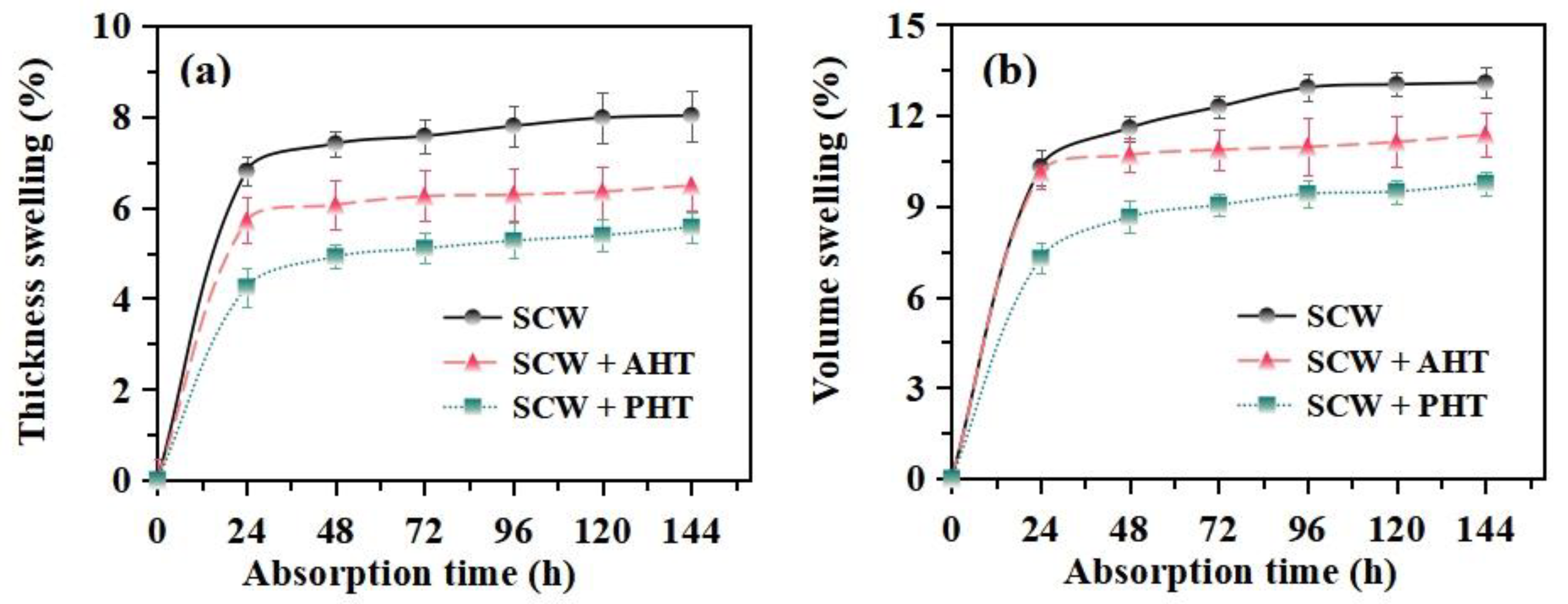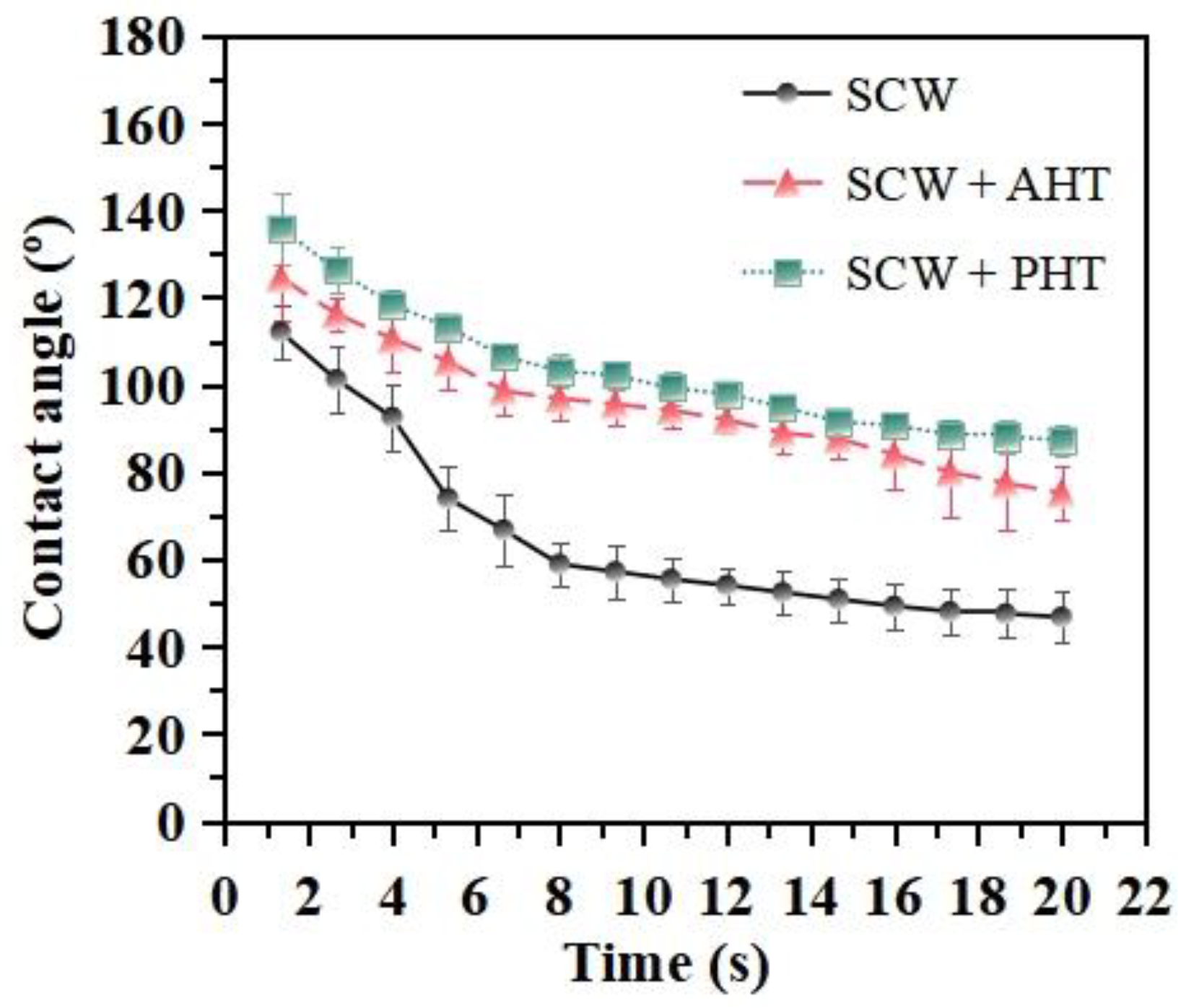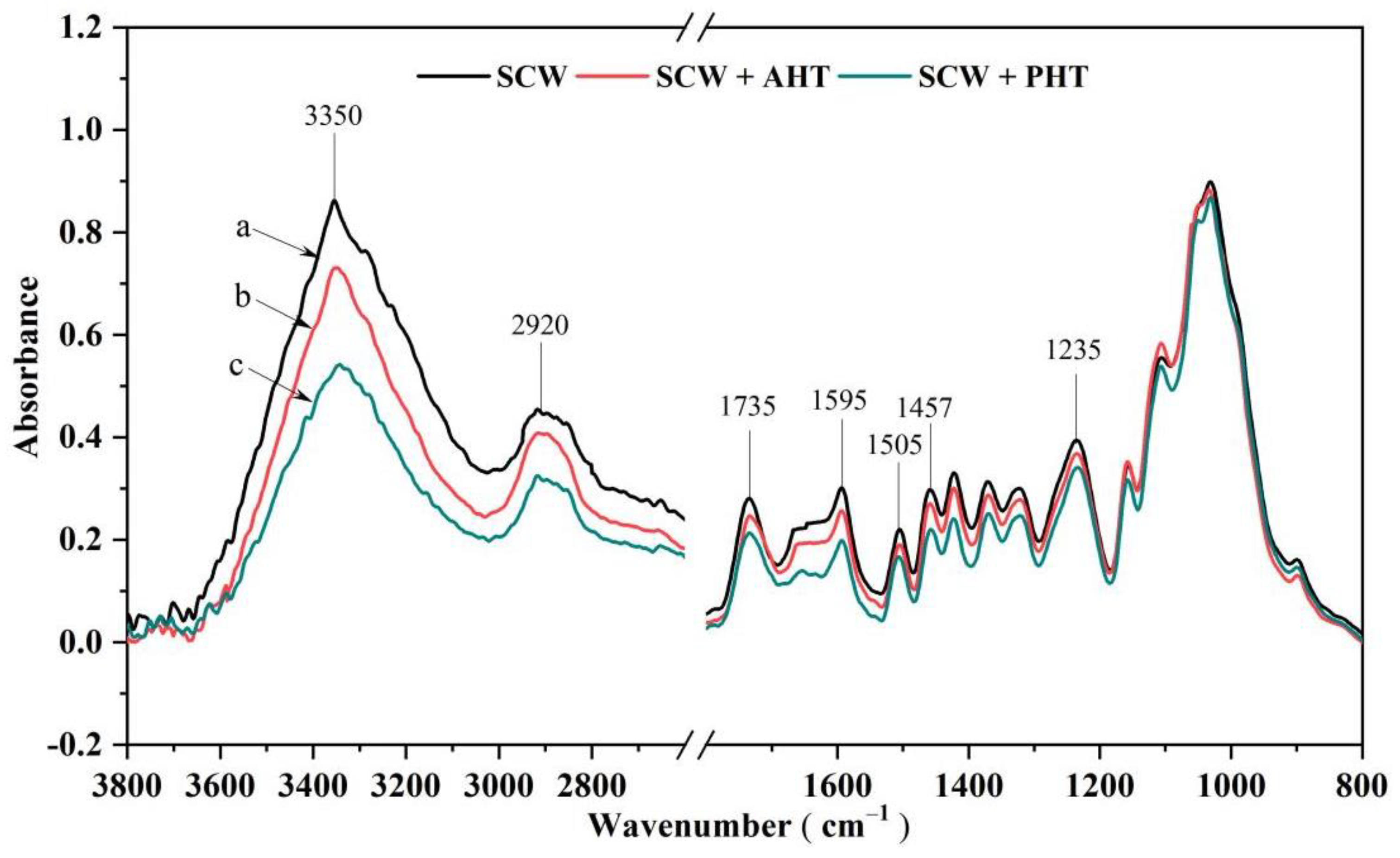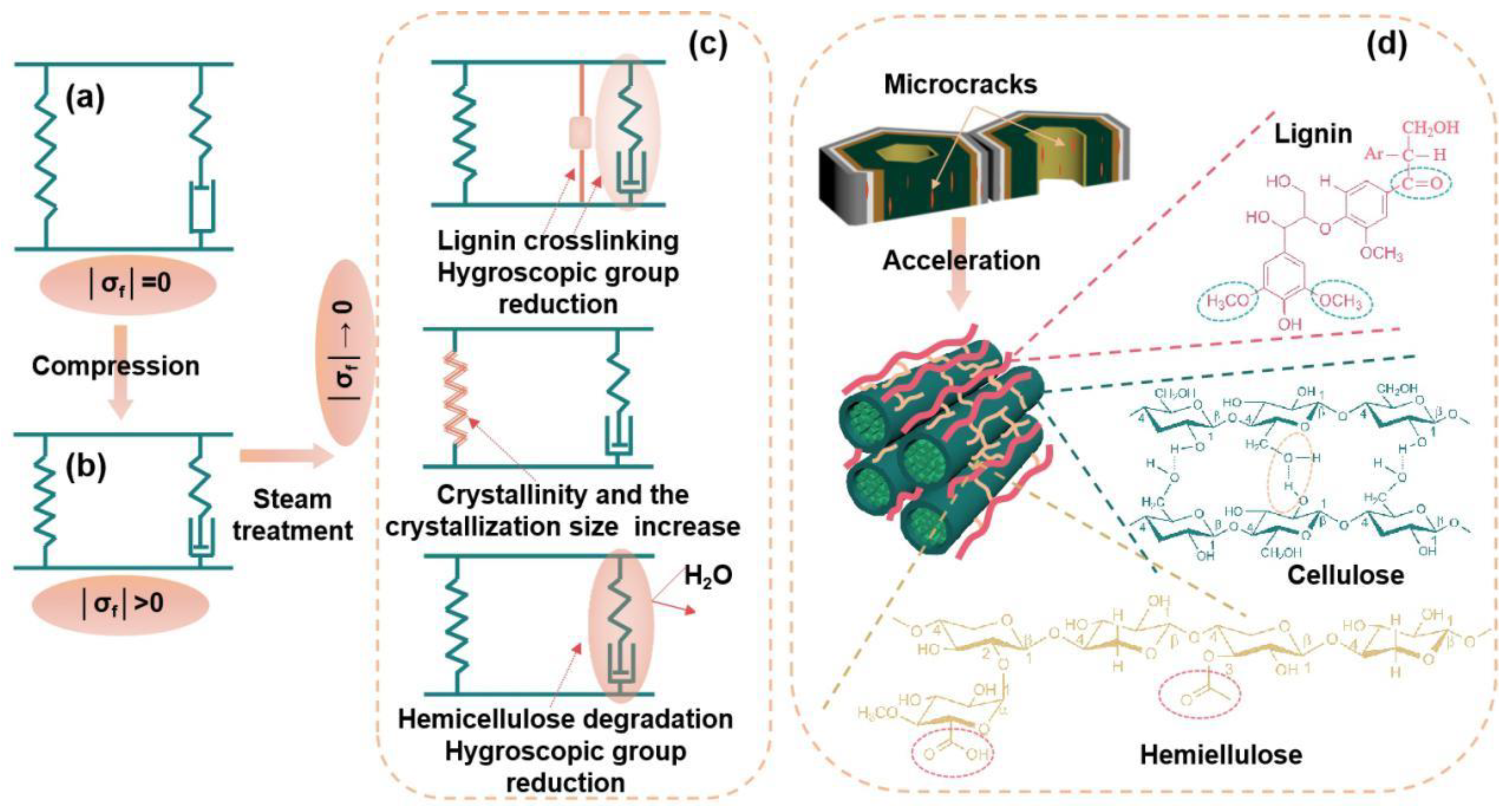Effects of Pressurized Superheated Steam Treatment on Dimensional Stability and Its Mechanisms in Surface-Compressed Wood
Abstract
:1. Introduction
2. Materials and Methods
2.1. Preparation of Wood Specimens
2.2. Surface Compression
2.3. Heat Treatment of Surface-Compressed Wood
2.4. Moisture Content
2.5. Determination of Dimensional Stability
2.6. Surface Wettability
2.7. Fourier Transformed Infrared (FTIR)
2.8. X-ray Diffraction
2.9. Morphological Structure
2.10. Statistical Evaluation
3. Results and Discussion
3.1. Dimensional Stability
3.1.1. Moisture Content
3.1.2. Moisture Absorption
3.1.3. Water Absorption
3.2. Surface Wettability
3.3. Chemical Structure
3.4. Cellulose Crystalline Structure
3.5. Microstructure
3.6. Suggested Mechanism of Dimensional Stability
4. Conclusions
Author Contributions
Funding
Institutional Review Board Statement
Informed Consent Statement
Data Availability Statement
Conflicts of Interest
References
- Navi, P.; Pizzi, A. Property changes in thermo-hydro-mechanical processing. Holzforschung 2015, 69, 863–873. [Google Scholar] [CrossRef]
- Fukuta, S.; Takasu, Y.; Sasaki, Y.; Hirashima, Y. Compressive deformation process of Japanese cedar (Cryptomeria japonica). Wood Fiber Sci. 2007, 39, 548–555. [Google Scholar]
- Laine, K.; Segerholm, K.; Wålinder, M.; Rautkari, L.; Hughes, M. Wood densification and thermal modification: Hardness, set-recovery and micromorphology. Wood Sci. Technol. 2016, 50, 883–894. [Google Scholar] [CrossRef]
- Zhan, J.; Avramidis, S. Transversal mechanical properties of surface-densified and hydrothermally modified needle fir wood. Wood Sci. Technol. 2017, 51, 721–738. [Google Scholar] [CrossRef]
- Xiang, E.; Huang, R.; Yang, S. Change in micromechanical behavior of surface densified wood cell walls in response to superheated steam treatment. Forests 2021, 12, 693. [Google Scholar] [CrossRef]
- Kamke, F.A.; Rathi, V.M. Apparatus for viscoelastic thermal compression of wood. Eur. J. Wood Wood Prod. 2011, 69, 483–487. [Google Scholar] [CrossRef]
- Guo, J.; Song, K.; Salmén, L.; Yin, Y. Changes of wood cell walls in response to hygro-mechanical steam treatment. Carbohydr. Polym. 2015, 115, 207–214. [Google Scholar] [CrossRef]
- Tu, D.; Su, X.; Zhang, T.; Fan, W.; Zhou, Q. Thermo-mechanical densification of Populus tomentosa var. with low moisture content. Bioresources 2014, 9, 3846–3856. [Google Scholar] [CrossRef] [Green Version]
- Rautkari, L.; Laine, K.; Kutnar, A.; Medved, S.; Hughes, M. Hardness and density profile of surface densified and thermally modified Scots pine in relation to degree of densification. J. Mater. Sci. 2013, 48, 2370–2375. [Google Scholar] [CrossRef]
- Inoue, M.; Kadokawa, N.; Nishio, J. Permanent fixation of compressive deformation by hydro-thermal treatment using moisture in wood. Wood Res. Tech. Notes 1993, 29, 54–61. [Google Scholar]
- Balasso, M.; Kutnar, A.; Niemelä, E.P.; Mikuljan, M.; Nolan, G.; Kotlarewski, N.; Hunt, M.; Jacobs, A.; O’Reilly-Wapstra, J. Wood properties characterisation of thermo-hydro mechanical treated plantation and native tasmanian timber species. Forests 2020, 11, 1189. [Google Scholar] [CrossRef]
- Popescu, M.-C.; Lisa, G.; Froidevaux, J.; Navi, P. Popescu C-MEvaluation of the thermal stability and set-recovery of thermo-hydro-mechanically treated lime (Tilia cordata) wood. Wood Sci. Technol. 2014, 48, 85–97. [Google Scholar] [CrossRef]
- Stamm, A.J. Thermal degradation of wood and cellulose. Ind. Eng. Chem. 1956, 48, 413–417. [Google Scholar] [CrossRef]
- Inoue, M.; Norimoto, M.; Tanahashi, M.; Rowell, R.M. Steam or heat fixation of compressed wood. Wood Fiber Sci. 1993, 25, 224–235. [Google Scholar]
- Dwianto, W.; Inoue, I.; Norimoto, M. Fixation of compressive deformation of wood by heat treatment. Mokuzai Gakkaishi 1997, 43, 303–309. [Google Scholar]
- Ito, Y.; Tanahashi, M.; Shigematsu, M.; Shinoda, Y.; Ohta, C. Compressive-molding of wood by high-pressure steam-treatment Part 1. Development of compressively molded squares from thinnings. Holzforschung 1998, 52, 211–216. [Google Scholar] [CrossRef]
- Navi, P.; Heger, F. Combined densification and thermo-hydro-mechanical processing of wood. MRS Bull. 2004, 29, 332–336. [Google Scholar] [CrossRef]
- Borrega, M.; Kärenlampi, P.P. Effect of relative humidity on thermal degradation of Norway spruce(Picea abies)wood. J. Wood Sci. 2008, 54, 323–328. [Google Scholar] [CrossRef]
- Chen, S.; Obataya, E.; Matsuo-Ueda, M. Shape fixation of compressed wood by steaming: A mechanism of shape fixation by rearrangement of crystalline cellulose. Wood Sci. Technol. 2018, 52, 1229–1241. [Google Scholar] [CrossRef]
- Morsing, N. Densification of Wood: The Influence of Hydrothermal Treatment on Compression of Beech Perpendicular to the Grain. Ph.D. Thesis, Technical University of Denmark, Lyngby, Denmark, 2000. [Google Scholar]
- Esteves, B.M.; Pereira, H.M. Wood modification by heat treatment: A review. Bioresources 2009, 4, 370–404. [Google Scholar] [CrossRef]
- Salmén, L.; Burgert, I. Cell wall features with regard to mechanical performance. A review COST Action E35 2004–2008: Wood machining-micromechanics and fracture. Holzforschung 2009, 63, 121–129. [Google Scholar] [CrossRef]
- Guo, J.; Rennhofer, H.; Yin, Y.; Lichtenegger, H.C. The influence of thermo-hygro-mechanical treatment on the micro- and nanoscale architecture of wood cell walls using small- and wide-angle X-ray scattering. Cellulose 2016, 23, 2325–2340. [Google Scholar] [CrossRef]
- Yin, J.P.; Yuan, T.Q.; Lu, Y.; Song, K.; Li, H.; Zhao, G.; Yin, Y. Effect of compression combined with steam treatment on the porosity, chemical composition and cellulose crystalline structure of wood cell walls. Carbohydr. Polym. 2017, 155, 163–172. [Google Scholar] [CrossRef] [PubMed]
- Gao, Z.; Huang, R.; Chang, J.; Li, R.; Wu, Y. Effects of pressurized superheated-steam heat treatment on set-recovery and mechanical properties of surface-compressed wood. BioResources 2019, 14, 1718–1730. [Google Scholar]
- Xiang, E.; Feng, S.; Yang, S.; Huang, R. Sandwich compression of wood: Effect of superheated steam treatment on sandwich compression fixation and its mechanisms. Wood Sci. Technol. 2020, 54, 529–1549. [Google Scholar] [CrossRef]
- Yin, Y.; Berglund, L.; Salmén, L. Effect of steam treatment on the properties of wood cell walls. Biomacromolecules 2011, 12, 194–202. [Google Scholar] [CrossRef]
- Li, X.; Fu, F.; Cai, Z.; Qiao, J.; Mou, Q.; Liu, Y.; Huang, Z. The effect of high temperature thermal treatment on moisture absorption and dimension stability of wood. J. Cent. South Univ. For. Technol. 2010, 30, 92–96. [Google Scholar]
- Ding, T.; Gu, L.; Liu, X. Comparative on Chemical Component Changes of Pressurized-Steam-Treated Mongolian Oak. Sci. Silvae Sin. 2012, 48, 148–152. [Google Scholar]
- Kutnar, A.; Kričej, B.; Pavlič, M.; Petrič, M. Influence of treatment temperature on wettability of Norway spruce thermally modified in vacuum. J. Adhes. Sci. Technol. 2013, 27, 963–972. [Google Scholar] [CrossRef]
- Wang, Z.; Sun, B.; Chai, Y.; Liu, J. Effect of vacuum heat treatment on the surface properties of larch (Larix kaempferi) wood. J. Northeast. For. Univ. 2005, 43, 65–68. [Google Scholar]
- Shupe, T.F.; Hse, C.Y.; Wang, W.H. An investigation of selected factors that influence hardness. Holzforschung 2001, 55, 541–548. [Google Scholar] [CrossRef]
- Bao, M.; Huang, X.; Zhang, Y.; Yu, W.; Yu, Y. Effect of density on the hygroscopicity and surface characteristics of hybrid poplar compreg. J. Wood Sci. 2016, 62, 441–451. [Google Scholar] [CrossRef] [Green Version]
- Li, J. Wood Spectroscopy; Science Press: Beijing, China, 2003. [Google Scholar]
- Tjeerdsma, B.F.; Militz, H. Chemical changes in hydrothermal treated wood: FTIR analysis of combined hydrothermal and dry heat-treated wood. Holz Als Roh- Und Werkst. 2005, 63, 102–111. [Google Scholar] [CrossRef]
- Li, X.; Liu, Y.; Gao, J.; Wu, Y.; Yi, S.; Wu, Z. Characteristics of FTIR and XRD for wood with high-temperature heating treatment. J. Beijing For. Univ. 2009, 31, 104–107. [Google Scholar]
- Åkerholm, M.; Salmén, L. Interactions between wood polymers studied by dynamic FT-IR spectroscopy. Polymer 2001, 42, 963–969. [Google Scholar] [CrossRef]
- Garrote, G.; Dominguez, H.; Paraj, J.C. Study on the deacetylation of hemicellulose during the hydrothermal processing of Eucalyptus wood. Holz Als Roh- Und Werkst. 2001, 59, 53–59. [Google Scholar] [CrossRef]
- Esteves, V.M.; Domingos, P. Chemical changes of heat treated pine and eucalypt wood monitored by FTIR. Maderas Cienc. Tecnol. 2013, 15, 245–258. [Google Scholar] [CrossRef] [Green Version]
- Popescu, M.-C.; Popescu, C.-M.; Lisa, G.; Sakata, Y. Evaluation of morphological and chemical aspects of different wood species by spectroscopy and thermal methods. J. Mol. Struct. 2011, 988, 65–72. [Google Scholar] [CrossRef]
- Colom, X.; Carrillo, F.; Nogués, F.; Garriga, P. Structural analysis of photodegraded wood by means of FTIR spectroscopy. Polym. Degrad. Stab. 2003, 80, 543–549. [Google Scholar] [CrossRef]
- Temiz, A.; Terziev, N.; Eikenes, M. Effect of accelerated weathering on surface chemistry of modified wood. Appl. Surf. Sci. 2007, 253, 5355–5362. [Google Scholar] [CrossRef]
- French, A.D. Idealized powder diffraction patterns for cellulose polymorphs. Cellulose 2014, 21, 885–896. [Google Scholar] [CrossRef]
- Toba, K.; Yamamoto, H.; Yoshida, M. Crystallization of cellulose microfibrils in wood cell wall by repeated dry-and-wet treatment, using X-ray diffraction technique. Cellulose 2013, 20, 633–643. [Google Scholar] [CrossRef]
- Kuribayashi, T.; Ogawa, Y.; Rochas, C.; Matsumoto, Y.; Heux, L.; Nishiyama, Y. Hydrothermal transformation of wood cellulose crystals into pseudo-orthorhombic structure by cocrystallization. ACS Macro Lett. 2016, 5, 730–734. [Google Scholar] [CrossRef]
- Awoyemi, L.; Jones, I.P. Anatomical explanations for the changes in properties of western red cedar (Thuja plicata) wood during heat treatment. Wood Sci. Technol. 2010, 45, 261–267. [Google Scholar] [CrossRef]
- Andersson, S.; Serimaa, R.; Väänänen, T.; Paakkari, T.; Jämsä, S.; Viitaniemi, P. X-ray scattering studies of thermally modified Scots pine (Pinus sylvestris L.). Holzforschung 2005, 59, 422–427. [Google Scholar] [CrossRef]








| Layers | Stratified Moisture Content (%) | EMC (%) | ||||
|---|---|---|---|---|---|---|
| 1 | 2 | 3 | 4 | 5 | ||
| SCW | 10.13 (0.43) | 11.42 (0.90) | 11.89 (0.60) | 10.88 (0.89) | 9.36 (0.05) | 10.74 |
| SCW + AHT | 9.83 (0.28) | 10.81 (0.40) | 10.77 (0.52) | 10.64 (0.25) | 9.92 (0.35) | 10.39 |
| SCW + PHT | 8.56 (0.26) | 8.58 (0.21) | 8.72 (0.24) | 8.68 (0.13) | 8.22 (0.08) | 8.55 |
Publisher’s Note: MDPI stays neutral with regard to jurisdictional claims in published maps and institutional affiliations. |
© 2022 by the authors. Licensee MDPI, Basel, Switzerland. This article is an open access article distributed under the terms and conditions of the Creative Commons Attribution (CC BY) license (https://creativecommons.org/licenses/by/4.0/).
Share and Cite
Gao, Z.; Huang, R. Effects of Pressurized Superheated Steam Treatment on Dimensional Stability and Its Mechanisms in Surface-Compressed Wood. Forests 2022, 13, 1230. https://doi.org/10.3390/f13081230
Gao Z, Huang R. Effects of Pressurized Superheated Steam Treatment on Dimensional Stability and Its Mechanisms in Surface-Compressed Wood. Forests. 2022; 13(8):1230. https://doi.org/10.3390/f13081230
Chicago/Turabian StyleGao, Zhiqiang, and Rongfeng Huang. 2022. "Effects of Pressurized Superheated Steam Treatment on Dimensional Stability and Its Mechanisms in Surface-Compressed Wood" Forests 13, no. 8: 1230. https://doi.org/10.3390/f13081230





